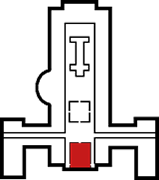Doric Hall
(Second Floor)
 |
 |
Doric Hall derives its name from the architectural style of its ten columns. It is located two floors beneath the dome and its appearance, although close to the original, was changed by the major restoration of the Bulfinch Front at the turn of the 20th century.
The original Doric columns were pine tree trunks carved on the front lawn of the State House. The present columns, installed as a fireproofing measure, are copies made of practical iron and plaster.
As a main reception room, Doric Hall serves as the setting for formal and informal gatherings—including banquets, press conferences, swearing-in ceremonies, and other special events. At the beginning of the Civil War, the state government used Doric Hall to distribute arms, ammunition, and other equipment to volunteers of the Sixth Massachusetts Militia Regiment. The men of the Sixth assembled in front of the State House and received their colors from Governor John Andrew; the units which arrived on April 19, 1861 in Washington, D.C. were the first organized military assistance President Lincoln received in the Civil War.
Doric Hall contains portraits, statues, and military artifacts recalling many periods of Massachusetts history. The 1826 marble statue of George Washington by Sir Frances Chantrey was the first to be placed in the State House. Governor Andrew is memorialized in Thomas Ball's marble sculpture, located to the left of Washington. Across the room is a rare full-length portrait of Abraham Lincoln, painted around 1900 by Albion Bicknell.
The two cannons beneath the Lincoln portrait commemorate the Concord Minutemen at the Battle of the North Bridge on April 19, 1775. The cannons on the opposite wall were used by the British East India Marine Company and are said to have been captured in the War of 1812. Between these cannons is a bronze bust of John Hancock, the first signer of the Declaration of Independence and the first governor elected after the adoption of the Constitution of the Commonwealth in 1780.